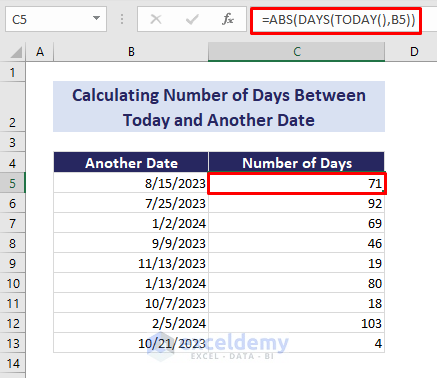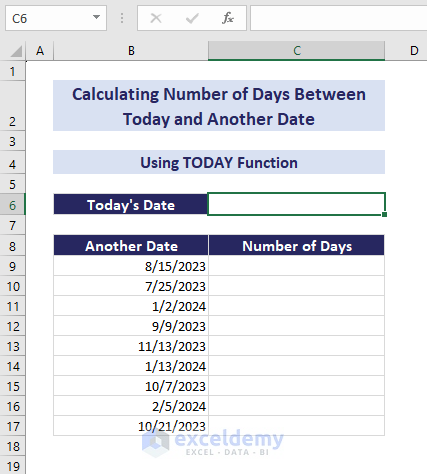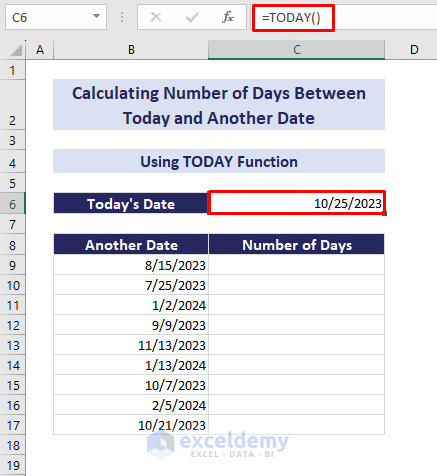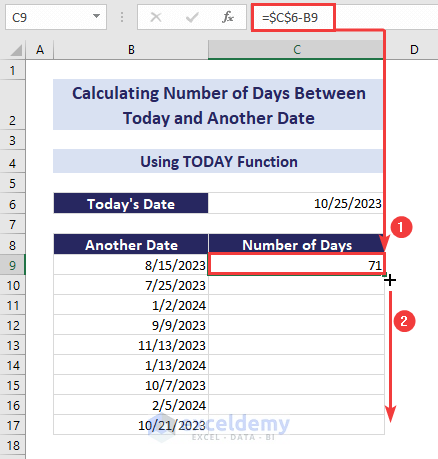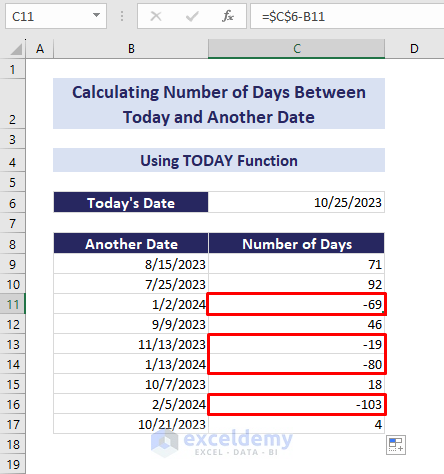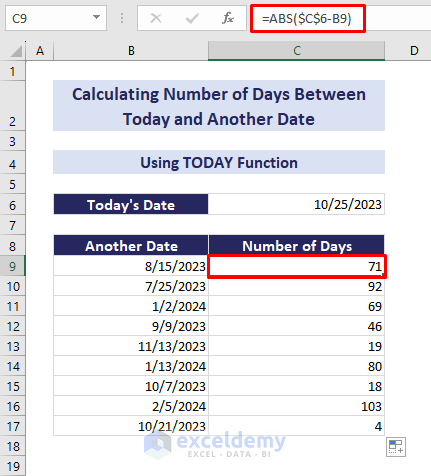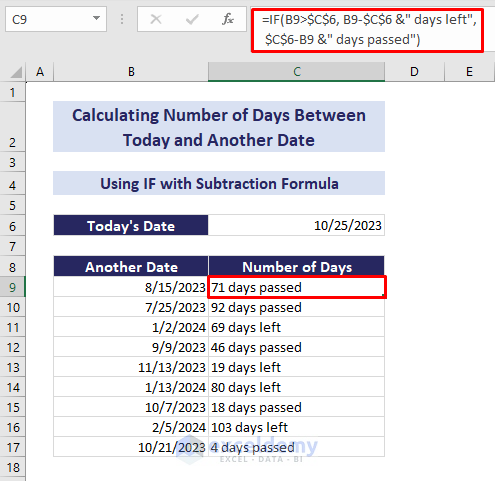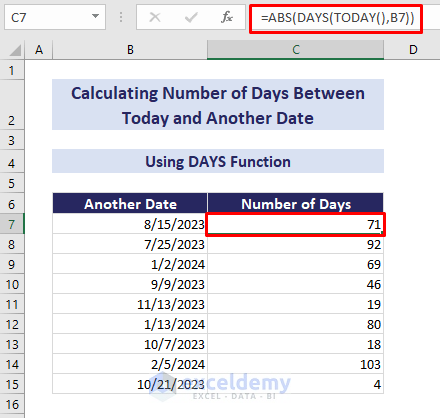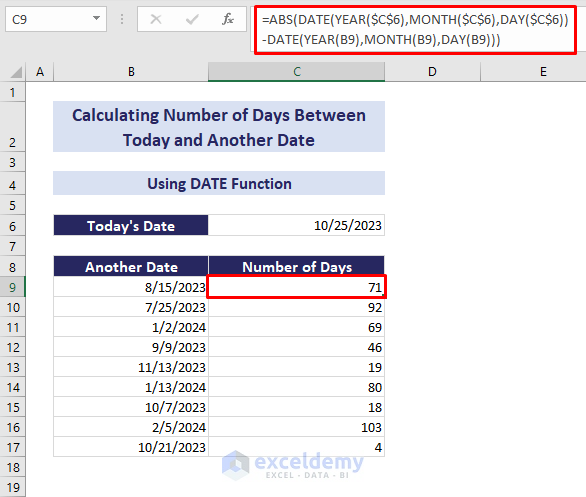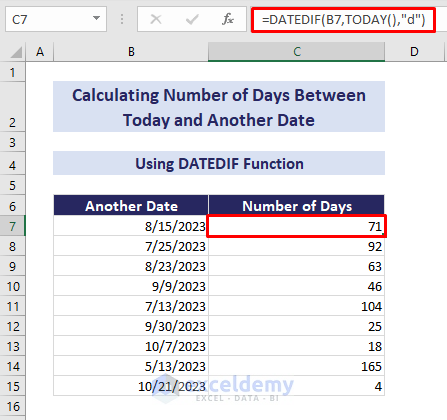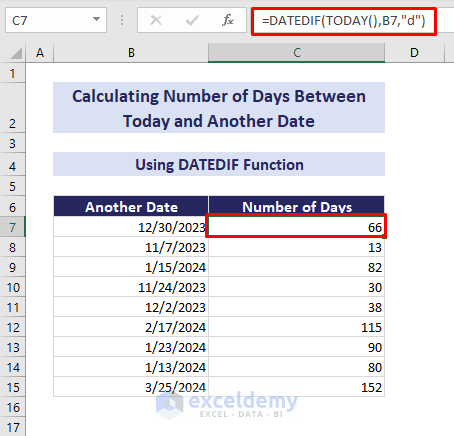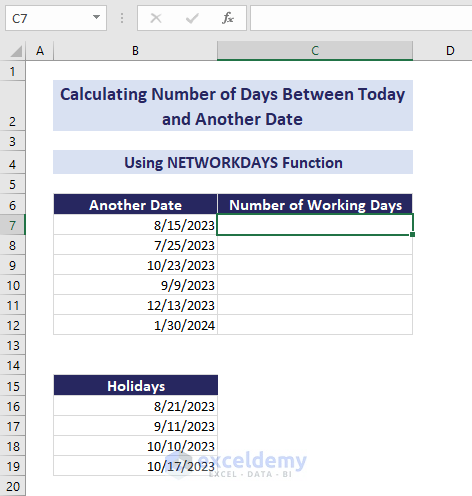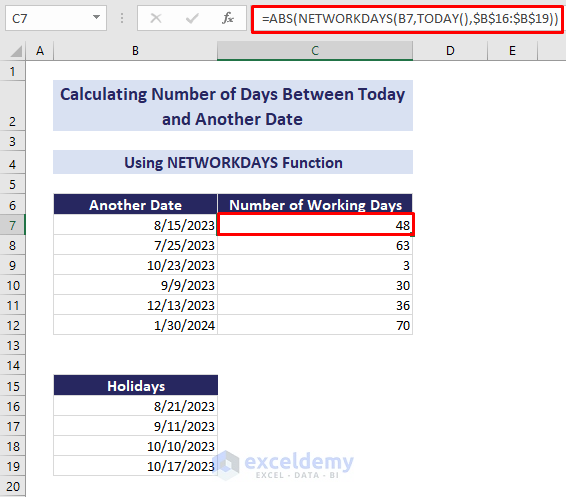Excel formula to calculate the number of days between today and another date means finding how many days have passed or left between today and another date using Excel formulas.
In this Excel tutorial, we’ll learn how to use an Excel formula to calculate the number of days between today and another date.
In the following overview image, we have some dates. Here, we have calculated the number of days between today and those dates using a formula.
We can calculate the number of days between today and another date using an Excel formula with the TODAY function and subtracting another date; DAYS function; DATE function; and DATEDIF function. We’ll also show how to calculate the number of working days between today and another date.
1. Using TODAY Function and Subtracting Another Date to Calculate Number of Days in Excel
In this section, we’ll use the TODAY function and subtract another date to calculate the number of days between today and another date in Excel. Moreover, we’ll show how to use the IF function to modify the formula outputs.
In the following dataset, we have some dates. We’ll calculate the number of days between those dates and today’s date. For this purpose, we’ll use a simple subtraction formula:
=Today’s date - Another dateBut first, we’ll find out today’s date.
So follow the steps below to complete the task.
Steps:
- Select cell C6 => Insert the formula:
=TODAY()- Press Enter. It’ll return today’s date.
- Select cell C9 => Write the formula:
=$C$6-B9- Press Enter.
- Use the Fill Handle to copy the formula in other cells below. It returns a negative number for those cases where the corresponding “Another Date” is in the future to today’s date.
- To get rid of the minus signs and return just the numbers alone, use the following formula with the ABS function:
=ABS($C$6-B9)Suppose, we want to add “days left” if the other date is in the future to today’s date. And we want to add “days passed” if the date is in the past to today’s date. The formula will be:
=IF(B10>$C$6, B10-$C$6 &" days left", $C$6-B10 &" days passed")Read More: Excel Calculates Difference Between Two Dates in Days
2. Applying DAYS Function to Determine Number of Days Between Today and Another Date
In this section, we’ll insert the DAYS function to get the number of days between today and another date in Excel.
The syntax of the function is:
=DAYS(end_date, start_date)If the end date is smaller than the start date, we’ll get a negative output. We can use the ABS function to get only the number value. The formula will be:
=ABS(DAYS(TODAY(),B7))Read More: Calculate Number of Days between Two Dates with VBA in Excel
3. Using DATE Function to Get Number of Days Between Today and Another Date
In this section, we’ll use the Excel DATE function to determine the number of days between today and another date.
The syntax of the function is:
=DATE(year, month, day)We’ll subtract two dates. The formula to be used is:
=ABS(DATE(YEAR($C$6),MONTH($C$6),DAY($C$6))-DATE(YEAR(B9),MONTH(B9),DAY(B9)))Read More: How to Find Number of Weeks Between Two Dates in Excel
4. Calculating Number of Days with Excel DATEDIF Function
In this section, we’ll apply the DATEDIF function to calculate the number of days between today and another date in Excel.
The syntax of the function is:
=DATEDIF(start_date, end_date, “d”)The “d” argument is to get the difference in days unit.
Here, the end date must be greater than the start date. Otherwise, the formula will result in an error. To avoid such incidents, we’ll show two separate cases where we deal with future and past dates compared to today’s date.
4.1 Past Date
In this part, we’ll use the DATEDIF function to calculate the number of days between today and past dates.
The formula will be:
=DATEDIF(B7,TODAY(),"d")4.2 Future Date
In this part, we’ll use the DATEDIF function to calculate the number of days between today and future dates.
The formula will be:
=DATEDIF(TODAY(),B7,"d")Read More: How to Count Months from Date to Today by Using Excel Formula
5. Calculating Number of Working Days Between Today and Another Date in Excel
In this section, we’ll calculate the number of working days between today and another date using the NETWORKDAYS function in Excel. We can also consider holidays along with the weekends while determining the working days.
The syntax of this function is:
=NETWORKDAYS(start_date, end_date, [holidays])In the following dataset, we have some dates and holidays. We’ll calculate the number of working days between those dates and today’s date.
The formula will be:
=ABS(NETWORKDAYS(B7,TODAY(),$B$16:$B$19))Read More: Excel Formula to Count Days from Date
Download Practice Workbook
Conclusion
This article has shown how to use an Excel formula to calculate the number of days between today and another date. Apply any one of the TODAY, DAYS, DATE, or DATEDIF functions to get the number of days. For the number of working days, use the NETWORKDAYS function. Leave a comment for any further queries.
Further Readings
- How to Calculate Expiration Date with Excel Formula
- How to Calculate Number of Months Between Two Dates in Excel
- How to Calculate Years from Today in Excel
- How to Calculate Years Between Two Dates in Excel
- Calculate Years and Months Between Two Dates in Excel
<< Go Back to Days Between Dates | Calculate Dates | Date-Time in Excel | Learn Excel
Get FREE Advanced Excel Exercises with Solutions!